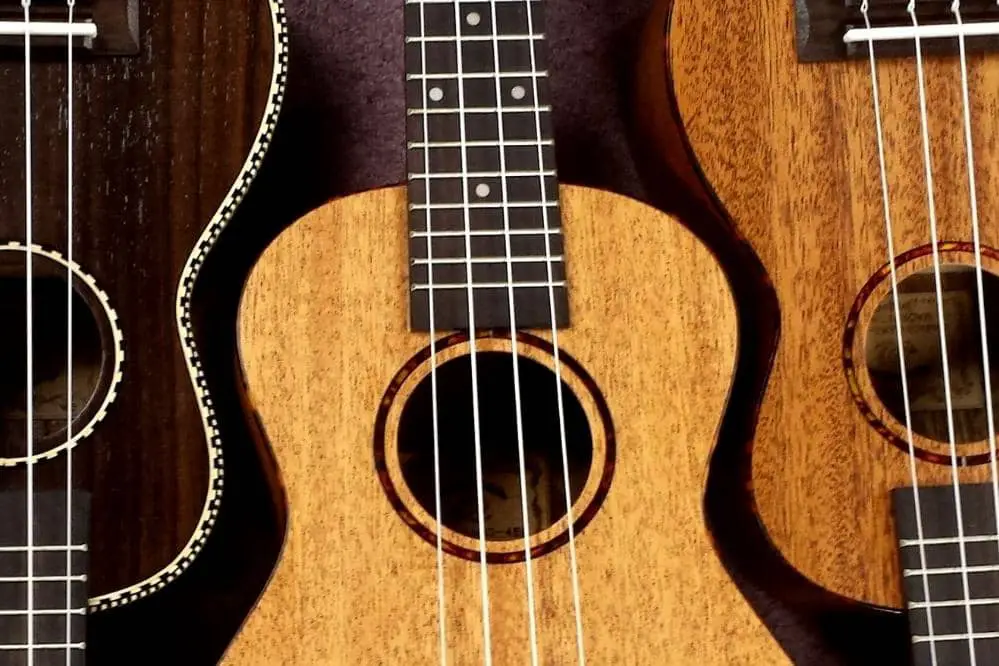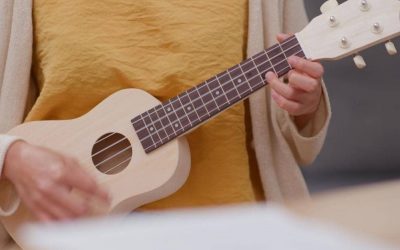A ukulele is a stringed instrument which resembles a small acoustic guitar. There are different types to choose from in a variety of sizes, types of wood and specific playing styles.
This instrument, which originated in Hawaii, comes in four main standard tonal ranges and sizes which can be categorized as follows:
- Soprano
- Concert
- Tenor
- Baritone
Since there are various kinds to choose from, it is a good idea to understand how each one differs, so you can determine the best ukulele for your needs. Let’s take a closer look at each one.
Soprano
The 21-inch long soprano ukulele is the most traditional type. This is the lightest and smallest ukulele in the family, featuring the tightest fret spacing and shortest scale. A soprano is a good choice for smaller hands although the size can present a challenge to some.
Because this model is relatively small, the tuning is going to sound more off the higher up the fretboard you get. The tone from a soprano will be softer, brighter and more crisp than with other sizes but this type of uke offers less resonance and projection. The soprano is still one of the most popular ukulele options.
Is the Soprano Ukulele Right for You?
Regardless of experience or skill, a soprano suits most players. However, given their smaller dimensions, they are especially good for children or those with smaller hands. Soprano ukuleles work well for chord strumming but not so well for picking notes.
This size would suit a beginner and it offers a good, traditional sound. However, if you have larger hands and fingers or prefer to play a more technical style, another size could be a better alternative.
Concert
The next size up from soprano, a concert ukulele has a longer neck and a larger body. It also weighs a bit more. The concert ukulele is more versatile since its extra length means more frets which have more spacing in between.
You can also play chords on a concert ukulele, not only chords like on the soprano. The higher up the fretboard you play, the better the intonation. Expect a warm, full sound. Concert ukuleles are louder than sopranos and also have some bass in the sound.
Is the Concert Ukulele Right for You?
Players of any experience and skill level, especially those with bigger hands and fingers, will find the concert size a joy to play. The versatility of this instrument means more experienced players will find that more playing styles can be accommodated. The concert ukulele is also nice for performances and isn’t heavy enough to make a strap a necessity.
Perhaps you are just starting out with the ukulele but are a little older. In this case, the concert ukulele would be a good choice. Expect a good sound and playability balance.
Tenor
The next size up from the concert ukulele, the tenor size, is about two inches longer and it also weighs more. The longer, wider neck makes fingerpicking styles easier and doesn’t limit those with larger hands and fingers.
As the tenor is a bigger size, you can expect a full and deep sound which includes a resonance with rich bass characteristics. They are louder than both the soprano and concert options and they still sound natural both when picking notes and when strumming chords.
Something else you can do with a tenor is change the G string to a low G. This will give you a greater range. A high G can sound a bit awkward when the sound jumps high when playing the fourth string. A low G sounds more natural, although the extra bass in the sound isn’t a traditional ukulele sound.
Some players like to have both types of G in their collection so they are interchangeable. However, others prefer to choose just one depending on their musical preference and playing style.
Is the Tenor Ukulele Right for You?
A tenor ukulele is the instrument of choice for many professional players but they’re also ideal for anyone wanting a deeper, fuller sound. Their size makes them suitable for those with larger hands and also for those who play a lot with a fingerpicking style.
The fact you can choose from the low or high G adds more range, versatility and options. Bear in mind the tuning for a tenor size is G, C, E, A, and the wider spacing on a tenor model can be a challenge for chords where you have to stretch the fingers.
Baritone
This type of ukulele offers a scale that’s three inches longer than that of the tenor. They also offer the widest fret spacing and neck. Expect the fullest, deepest sound from this size of ukulele.
This one sounds more like an acoustic guitar than the other models and the standard tuning is D, G, B, E, which is similar to a guitar’s four highest strings.
Is the Baritone Ukulele Right for You?
If you already play the guitar, a baritone uke is the simplest to transition to and vice versa. If you want to learn the ukulele and then the guitar, it works both ways. The tuning is similar to that of a guitar and this large size ukulele can make such a transition easier.
If you want to stick with playing the ukulele as your main instrument, you might prefer to look at alternatives though. A non-guitar player or ukulele beginner might find a baritone’s non-standard tuning a challenge.
What Types of Wood are Ukuleles made of?
Various ukulele models can be made with different kinds of wood. Some are made using just one type while others might have a fretboard or back and sides made of one kind of wood and the rest made from another.
There are plenty of choices here so we are going to be looking at the most common ones, which are:
- Mahogany
- Maple
- Koa
- Spruce
- Rosewood
Mahogany Ukuleles
This type of wood is perhaps the most popular of all. Expect a mahogany ukulele to offer a nicely balanced tone between the low bass notes and high trebles, to give a traditional, classic ukulele sound. These instruments are especially great with midrange tones and give a more punchy sound than most other types of wood. Since mahogany is a hardwood it is heavier than some other types.
Maple Ukuleles
Formerly known for their distinct treble sound and clarity, maple can be paired with spruce to make a durable instrument. These days however there are alternatives which sustain better and the resonance isn’t as good with maple either. This wood does look beautiful and produce a bright sound.
Koa Ukuleles
These have good sustain and a pleasant overall tone. Koa ukuleles, especially ones made in Hawaii, are a popular choice. Koa is wonderful for midrange, like with mahogany and it’s also an attractive looking wood. The body is slick and clean and players of any skill level would make a good choice with koa.
Spruce Ukuleles
Spruce is a softwood but a strong one. The tone it produces is vibrant and crisp. The warm sound it makes is dominant in the lower and middle registers. Spruce ukes are an attractive pale golden color and boast consistent note articulation and bass response. A nice choice for dynamic strummers, this type of ukulele is performs well across a wide range of frequencies.
Rosewood Ukuleles
Although rosewood isn’t a common choice in the ukulele world, it does have its own benefits. It offers a nice balance of low and mid-range tones as well as smooth accentuated highs. Rosewood is a popular fretboard material for ukuleles but you can also fine instruments solely made of this wood. Many guitars and ukuleles have rosewood sides and backs because it helps to create warm, resonating tones.
Other Ukulele Materials
Not only does this instrument come in a variety of sizes and types of wood, but there are more factors distinguishing the different types. Wood is the material of choice but you can also get laminate ukes which offer a different sound.
Laminated wood ukuleles are made by gluing several thinner pieces of wood together and perhaps topping them with a veneer. A laminate uke will always sound the same while a solid wood one will mellow with age and the tones will eventually be richer, so either one is a possibility.
Avoid anything made from plastic though since you’d be sacrificing a lot of sound quality and even if you’re on a tight budget you can still find a good wood or laminate model.
In Conclusion
You will need to dedicate time and money to learning this instrument if you’re a newbie. If you’re serious about playing, we recommend you pick a good quality instrument with well-crafted strings for the best sound as well as the most enjoyment.
Before making your final decision, consider factors such as what style of playing you intend to focus on, the size and dexterity of your hands and fingers, what dimensions and weight you are comfortable with, and your budget.




